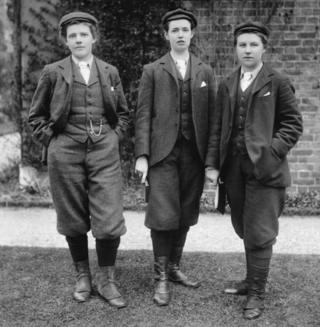Trail-blazing gardening women of Kew

 Image copyright Royal Botanic Gardens, Kew
Image copyright Royal Botanic Gardens, Kew London in 1896, and a curious turn of history.
Women gardeners were employed for the first time at Kew, and on equal pay, decades before women gained the vote.
Made to wear the same garb as male gardeners so as not to distract their colleagues, their brown woollen bloomers soon made the news.
As the satirical magazine, Punch, put it, “They gardened in bloomers the newspapers said. So to Kew without waiting all Londoners sped.”
After a blaze of publicity, the powers that be changed their minds and skirts were reinstated.
Now, more than a century on, Kiri Ross-Jones, archivist and records manager at the Royal Botanic Gardens, Kew, reflects on the trail blazers of Kew.
She says it’s incredible that at this point in time, women were in horticultural employment.
“They worked long days, there was a lot of physical work involved in it – and also the studying side of it as well – these women were studying in organic chemistry and physics as well as botany and horticulture.
“And I think it’s just amazing that at this point in time these women were doing that here at Kew.”
Annie Gulvin, Alice Hutchings, Gertrude Cope and Eleanor Morland, who trained together at Swanley Horticultural College, became the first female gardeners at Kew.
Their days were long, digging in the dirt from 6am to 6pm in the summer months. They were expected to spend their evenings attending lectures or studying in the library.
“As far as we can tell, the women were employed on exactly the same terms as the men – and they appear to have been paid the same salary – it was quite a low salary for that day – but it was, as far as we can tell, exactly the same as the male gardeners,” says Kiri Ross-Jones.
Dr Catherine Horwood, a writer and social historian on women’s horticultural history, says the appointments were enormously significant. Until then, the only women on the payroll at Kew were caretakers and a pot-washer in the tropical department.
“Although women at that time could pay to learn about horticulture, this was the first time they could earn a wage while honing their horticultural skills,” she says.
The writers of the Journal of the Kew Guild for 1896 had mixed feelings about the employment of female gardeners: “Some of the work seems too laborious for them but this is their affair… Given fair play and no favour we do not object to anyone competing in the field of horticulture, be it prince or peer, retired army officer or young lady. The pity it is that in the case of women, marriage would terminate their gardening career.”
As it turned out, the experiment was to last only a few years. By 1898, Alice Hutchins had been promoted to sub-foreman, Annie Gulvin had left, and a small number of other women had joined the gardens.
Kiri Ross-Jones says it was normal for students to be employed at Kew only for a couple of years and then to move on to better paid positions.
“Pleasingly, looking at our records that does appear to be what seemed to happen to these women,” she says. “They generally moved on to roles as head gardeners in some cases at other large gardens.”
Although it was a challenge for women to find jobs, Gertrude Cope went on to work with another pioneering female gardener, Miss Harrison, at gardens near Birmingham owned by George Cadbury.
After 1902, there were no more female gardeners at Kew until the First World War came along, and women were needed to replace the men who had gone to fight.
Women were recruited once again during the Second World War, but it was only in the 1970s when their number increased to become equal with male students.
Eli Biondi who supervises the Princess of Wales Conservatory at Kew says gardeners there today are united by a common interest and passion in plants.
The early women were heroic, she says. “It’s thanks to them that I’m here and I’ve got a a very exciting and interesting job in one of the most famous botanic gardens in the world.”
Follow Helen on Twitter.






